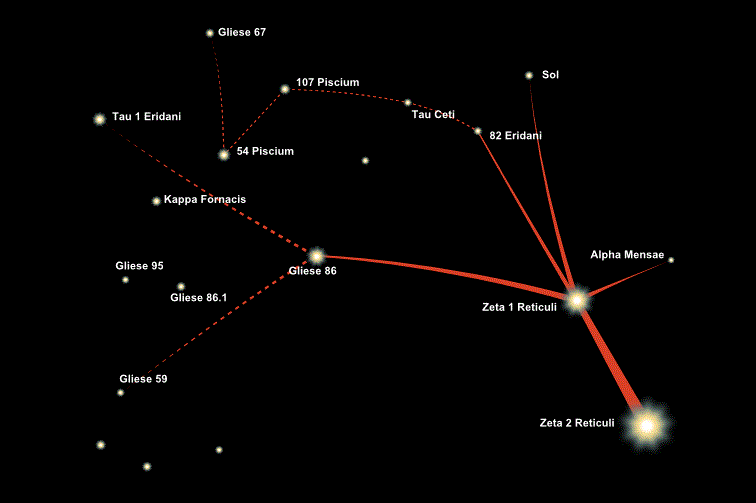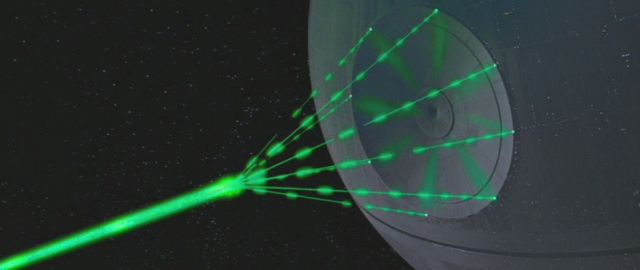
Moderators: Elvis, DrVolin, Jeff
A planet with conditions that could support life orbits a twin neighbour of the sun visible to the naked eye, scientists have revealed.
The world is one of five thought to be circling Tau Ceti, a star just 12 light years away that is almost identical to the sun.
Astronomers estimate the Tau Ceti planets to be two to six times bigger than Earth. One of them, with five times the Earth's mass, lies in the star's "habitable zone".
Also known as the "Goldilocks zone", this is the orbital region that is neither too hot nor too cold to allow liquid surface water and, potentially, life. Details of the discovery are to appear in the journal Astronomy & Astrophysics.
Because of the difficulties involved in detecting extra-solar planets, most found so far have had high masses. The Tau Ceti planetary family is thought to be the lowest-mass solar system yet detected.
Scientists found the planets using a highly sensitive technique that combined data from more than 6,000 observations from three different telescopes. They used the radial velocity method, which looks for "wobble" in a star's movement caused by the gravitational tug of planets.
Dr James Jenkins, a member of the international team from the University of Hertfordshire, said: "Tau Ceti is one of our nearest cosmic neighbours and so bright that we may be able to study the atmospheres of these planets in the not-too-distant future.
"Planetary systems found around nearby stars close to our sun indicate that these systems are common in our Milky Way galaxy."
More than 800 planets have been discovered orbiting stars beyond the sun since the 1990s. Those found around the nearest sun-like stars are the most interesting to astronomers.
Professor Steve Vogt, another team member, from the University of California at Santa Cruz, said: "This discovery is in keeping with our emerging view that virtually every star has planets, and that the galaxy must have many such potentially habitable Earth-sized planets. They are everywhere, even right next door."
Professor Chris Tinney, an Australian member from the University of New South Wales, said: "As we stare at the night sky, it is worth contemplating that there may well be more planets out there than there are stars, some fraction of which may well be habitable."
"The situation is even worse for the possible habitable zone candidate, because the very existence of that signal is uncertain, yet according to our detection criteria the signal is there and we cannot rule out the possibility that it indeed is of planetary origin," he added. "But we don't know what else it could be, either."


Lonely Alien Planet Discovered Without a Parent Star
Megan Gannon, News Editor | SPACE.com – 1 hr 46 mins ago
Astronomers have discovered a lonely planet that's floating by itself in deep space without orbiting a star.
The powerful Pan-STARRS 1 (PS1) telescope at the summit of Maui's Haleakala volcano in Hawaii first detected the solitary alien world through a faint heat signature 80 light-years from Earth while it was searching for brown dwarfs.
Dubbed PSO J318.5-22, the exoplanet is relatively young at 12 million years old, researchers say. With a mass about six times that of Jupiter, the planet resembles gas giants that orbit young stars, follow-up observations with other telescopes showed. But the one thing it appears to be missing is a parent star. [See Images of the Strangest Alien Planets]
"We have never before seen an object free-floating in space that that looks like this. It has all the characteristics of young planets found around other stars, but it is drifting out there all alone," study researcher Michael Liu, of the Institute for Astronomy at the University of Hawaii at Manoa, said in a statement. "I had often wondered if such solitary objects exist, and now we know they do."
The absence of a bright star could be a boon for scientists trying to understand the nature of planets outside our solar system, only a handful of which have been observed through direct imaging. Researchers typically study these alien worlds through indirect means, such as watching for the dips in starlight that occur when an exoplanet crosses in front of its star.
"Planets found by direct imaging are incredibly hard to study, since they are right next to their much brighter host stars," Niall Deacon, of the Max Planck Institute for Astronomy in Germany, explained in a statement. "PSO J318.5-22 is not orbiting a star so it will be much easier for us to study. It is going to provide a wonderful view into the inner workings of gas-giant planets like Jupiter shortly after their birth."
The number of known exoplanets has exploded over the past 10 years. Astronomers have confirmed more than 800, but some estimates suggest there are likely be tens of billions of exoplanets in the universe.
PSO J318.5-22 was inadvertently discovered during a survey of brown dwarfs, starlike cosmic objects sometimes called "failed stars" because they are bigger than planets but too cold to flare up into a veritable star.
In their search for the dim red signals of brown dwarfs, astronomers chose to use PanSTARRS 1 (PS1), short for Panoramic Survey Telescope and Rapid Response System, which takes the equivalent of 60,000 iPhone photos each night.
"We often describe looking for rare celestial objects as akin to searching for a needle in a haystack," Eugene Magnier of the Institute for Astronomy said in a statement. "So we decided to search the biggest haystack that exists in astronomy, the dataset from PS1."
In their survey, they spotted PSO J318.5-22, an object redder than even the reddest known brown dwarfs. The researchers watched the planet for two years and concluded that it lies in a collection of 12-million-year-old stars called the Beta Pictoris moving group.
Observations with other telescopes found signatures in the cosmic body's infrared light that are best explained by it being young and low-mass. In fact, PSO J318.5-22 is one of the lowest-mass free-floating objects known, the researchers say.
http://news.yahoo.com/lonely-alien-plan ... 15695.html


JackRiddler » Fri Oct 11, 2013 4:34 pm wrote:Hence the process of solar formation produces planets at stable orbits along an elliptical, some gas giants, some rock-spheres. (These formed with the system as a whole, or they wouldn't be on an elliptical.
The ecliptic is the apparent path of the Sun on the celestial sphere, and is the basis for the ecliptic coordinate system...
Most of the bodies of the Solar System orbit the Sun in nearly the same plane. This is likely due to the way in which the Solar System formed from a protoplanetary disk. Probably the closest current representation of the disk is known as the invariable plane of the Solar System. The Earth's orbit, and hence, the ecliptic, is inclined a little more than 1° to the invariable plane, and the other major planets are also within about 6° of it. Because of this, most Solar System bodies appear very close to the ecliptic in the sky. The ecliptic is well defined by the motion of the Sun. The invariable plane is defined by the angular momentum of the entire Solar System, essentially the summation of all of the revolutions and rotations of all the bodies of the system, a somewhat uncertain value which requires precise knowledge of every object in the system. For these reasons, the ecliptic is used as the reference plane of the Solar System out of convenience.
MinM » Fri Oct 11, 2013 10:19 am wrote:
Lonely Alien Planet Discovered Without a Parent Star
Megan Gannon, News Editor | SPACE.com – 1 hr 46 mins ago
Astronomers have discovered a lonely planet that's floating by itself in deep space without orbiting a star.
The powerful Pan-STARRS 1 (PS1) telescope at the summit of Maui's Haleakala volcano in Hawaii first detected the solitary alien world through a faint heat signature 80 light-years from Earth while it was searching for brown dwarfs.
Dubbed PSO J318.5-22, the exoplanet is relatively young at 12 million years old, researchers say. With a mass about six times that of Jupiter, the planet resembles gas giants that orbit young stars, follow-up observations with other telescopes showed. But the one thing it appears to be missing is a parent star. [See Images of the Strangest Alien Planets]
"We have never before seen an object free-floating in space that that looks like this. It has all the characteristics of young planets found around other stars, but it is drifting out there all alone," study researcher Michael Liu, of the Institute for Astronomy at the University of Hawaii at Manoa, said in a statement. "I had often wondered if such solitary objects exist, and now we know they do."
The absence of a bright star could be a boon for scientists trying to understand the nature of planets outside our solar system, only a handful of which have been observed through direct imaging. Researchers typically study these alien worlds through indirect means, such as watching for the dips in starlight that occur when an exoplanet crosses in front of its star.
"Planets found by direct imaging are incredibly hard to study, since they are right next to their much brighter host stars," Niall Deacon, of the Max Planck Institute for Astronomy in Germany, explained in a statement. "PSO J318.5-22 is not orbiting a star so it will be much easier for us to study. It is going to provide a wonderful view into the inner workings of gas-giant planets like Jupiter shortly after their birth."
The number of known exoplanets has exploded over the past 10 years. Astronomers have confirmed more than 800, but some estimates suggest there are likely be tens of billions of exoplanets in the universe.
PSO J318.5-22 was inadvertently discovered during a survey of brown dwarfs, starlike cosmic objects sometimes called "failed stars" because they are bigger than planets but too cold to flare up into a veritable star.
In their search for the dim red signals of brown dwarfs, astronomers chose to use PanSTARRS 1 (PS1), short for Panoramic Survey Telescope and Rapid Response System, which takes the equivalent of 60,000 iPhone photos each night.
"We often describe looking for rare celestial objects as akin to searching for a needle in a haystack," Eugene Magnier of the Institute for Astronomy said in a statement. "So we decided to search the biggest haystack that exists in astronomy, the dataset from PS1."
In their survey, they spotted PSO J318.5-22, an object redder than even the reddest known brown dwarfs. The researchers watched the planet for two years and concluded that it lies in a collection of 12-million-year-old stars called the Beta Pictoris moving group.
Observations with other telescopes found signatures in the cosmic body's infrared light that are best explained by it being young and low-mass. In fact, PSO J318.5-22 is one of the lowest-mass free-floating objects known, the researchers say.
http://news.yahoo.com/lonely-alien-plan ... 15695.html
Users browsing this forum: No registered users and 6 guests